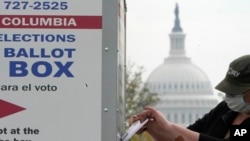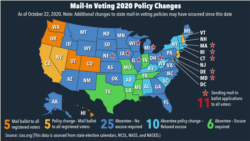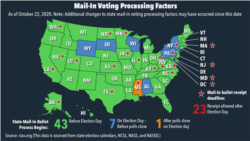During every U.S. presidential election, hundreds of thousands of mail-in ballots are discarded by election officials for a variety of reasons, from arriving too late to missing a proper signature on the outer envelope.
But this year, with more than half of U.S. voters casting ballots early or by mail, even more absentee ballots are being tossed out, raising questions about voting rights and heightening the specter of post-election uncertainty in key battleground states.
Consider Florida and North Carolina, two Southern states where President Donald Trump and his Democratic rival, former Vice President Joe Biden, have been running neck and neck ahead of the November 3 election.
While Florida and North Carolina don’t publish data on ballot rejections before the election, two academics — Dartmouth College professor Michael Herron and University of Florida professor Daniel Smith — have analyzed the states’ official mail-in data to tally the number of votes at risk of rejection.
In Florida, out of 3.8 million mail-in ballots cast so far, more than 15,000 face dismissal, a rejection rate of 0.4 percent, according to Herron and Smith. In North Carolina, the rejection rate is even higher. As of October 25, out of more than 780,000 ballots mailed in the state, more than 10,000 face possible rejection, a disqualification rate of about 1.3%, their research found.
Minority voters
As in some recent elections, more minority than white voters are facing ballot rejections. In North Carolina, for example, Black voters were three times more likely than white voters to have their ballots flagged, the researchers found. This is something the Democrats could use as an issue should they decide to challenge the results of close races.
To be sure, not every ballot marked as deficient will be automatically rejected. In both states, as in many others, voters are given an opportunity to “cure” or correct mistakes on their ballots.
“It would be premature at this juncture to conclude that those returned ballots have been rejected by the canvassing board and not counted,” said Mark Ard, interim communications director for the Florida Department of State.
In North Carolina, officials have started contacting voters with erroneous ballots, said Patrick Gannon, public information director for the North Carolina State Board of Elections.
“A voter who for any reason does not have time to cure the ballot may vote in person during the early voting period through October 31 or on Election Day,” Gannon said via email.
At first glance, the number of Florida and North Carolina ballots flagged for rejection appears modest. However, in Florida and North Carolina, as in other states with historically close elections, 10,000 votes can sometimes be the difference between victory and defeat.
The outcome of the 2000 presidential election between Republican George W. Bush, the ultimate victor, and Democrat Al Gore came down to 537 votes in Florida. And during the 2018 primary election for a U.S. Senate seat from Florida, Republican Rick Scott won by just 10,033 votes, the researchers noted.
As more mail ballots arrive in the coming days, the number of rejected ballots is likely to grow, in some cases potentially surpassing the margin of victory between candidates in closely fought presidential, congressional, state or local races in battleground states.
“That's a really nightmarish scenario when an election is so close that the number of rejected ballots is greater than the margin,” Herron said in an interview.
As of Wednesday, 49 million Americans had voted by mail, according to a tally by the U.S. Elections Project.
Herron and Smith first published their findings in The Conversation, a research publication. They shared more up-to-date data from Florida and North Carolina with VOA.
Court battles
The issues of how to handle ballots with signature problems and how long past November 3 mail-in ballots can arrive and still be counted have been the subject of months-long court battles by Republicans and Democrats throughout the country.
With more Democrats than Republicans voting by mail, Republicans have sought court intervention, with varying degrees of success, to prevent late-arriving ballots from being entered into the final tally.
In recent weeks, the conservative-controlled U.S. Supreme Court has ruled against efforts to change election procedures, including ballot receipt deadlines, invoking a doctrine that holds election rules should not be changed close to a vote.
On October 19, before Trump’s latest Supreme Court nominee, Amy Coney Barrett, was confirmed, the justices split 4-4 over Pennsylvania’s plan to count the votes until three days after Election Day, even if they don’t have a legible postmark. On Wednesday, the justices refused to fast-track a new Republican challenge to Pennsylvania's extended vote-counting deadline.
But earlier this week, in a ruling viewed as a major setback for the Democrats, the high court blocked a Wisconsin plan to count mail-in ballots for up to six days after the election.
Hans von Spakovsky, senior legal fellow at the conservative Heritage Foundation in Washington, said rejected mail-in ballots are ripe for post-election litigation.
“I suspect we may have big delays in the counting of ballots if there is a significant increase in absentee ballots, and I think there may also be litigation over the rejection of absentee ballots that did not comply with state law,” von Spakovsky, a former Republican member of the Federal Election Commission, said in a recent interview.
Historically, less than 1% of absentee votes get rejected because of administrative errors. But with record numbers of people voting by mail this year, many of them first-time voters, at least 1 million ballots could be discarded, according to a recent projection by a joint investigation by USA Today, Columbia Journalism Investigations and the PBS series Frontline.
During this year’s presidential primaries, more than 550,000 mail-in ballots were discarded in 30 states, far more than the total for the 2016 presidential election, according to an analysis by NPR in August. That happened in large part because states were unprepared for the surge in voting by mail during the pandemic, noted Tammy Patrick, a former Arizona election official now with the foundation Democracy Fund.
In the months since the primaries, however, many states have adopted a number of voting-by-mail best practices, changes that will likely reduce the number of rejected ballots, Patrick said.
“They have redone their voting instructions. They have redone the design of their ballot envelopes. They have adopted practices like ballot tracking,” Patrick said.
Voters can now check their voting status online and in at least 19 states are notified when their mail ballots need to be corrected. In Colorado, voters with deficient ballots are notified by text message and allowed to correct the error on their smartphones.
As a result, Patrick said, fewer ballots will ultimately be rejected during the general election.
“It might be a little bit higher than a traditional presidential election because there still will be so many new voters, but I’m hopeful that we won't see the same kind of numbers we saw in the primary,” Patrick said.
One wild card, however, is the number of mail-in ballots that arrive after Election Day. While some states have extended their ballot receipt deadlines, 32 states, including Florida, don’t accept ballots that arrive after Election Day, giving voters little time to cure their ballots. North Carolina accepts ballots until November 12 if they are postmarked on or before November 3. The Supreme Court late Wednesday rejected a Republicans challenge to the extended deadline.
“I think the big, lurking question out there is how many ballots arrive after Election Day,” Herron said.













